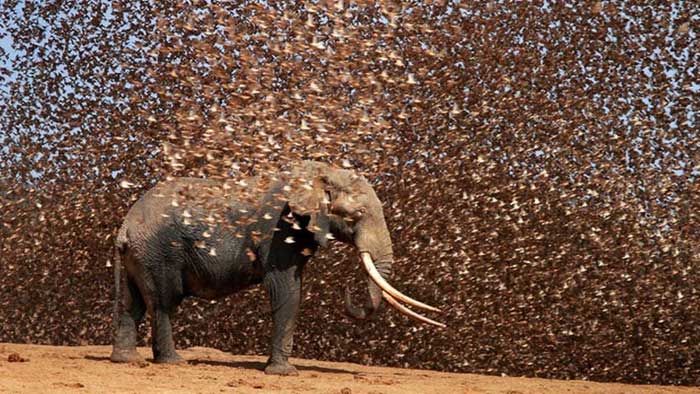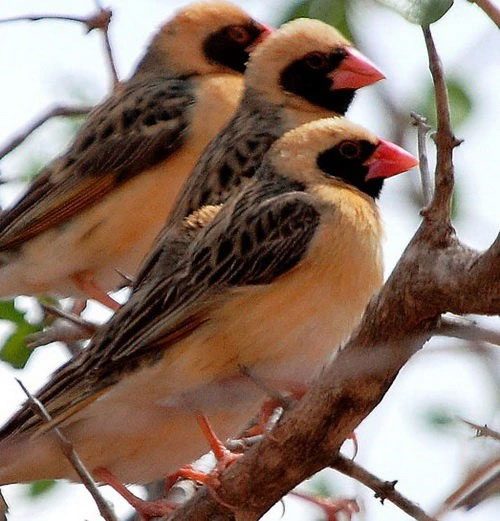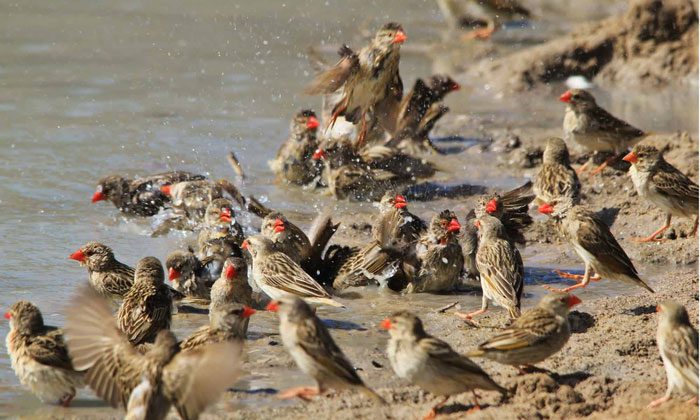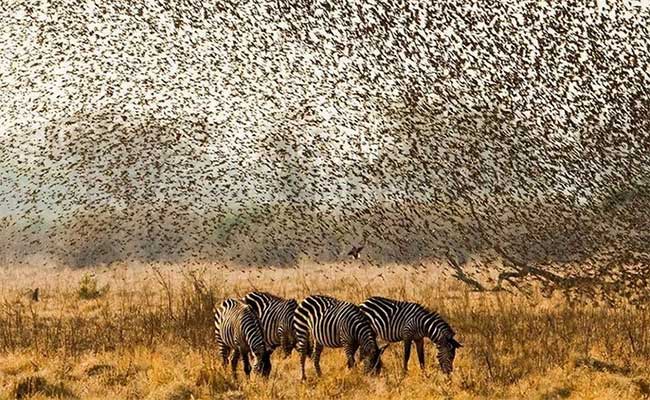For many, the idea of a sparrow defeating an elephant seems unimaginable, given the vast difference in body size between the two species. A sparrow’s body length is only about ten centimeters, while an elephant can reach lengths of up to 4 meters.
In 2017, an incident of “sparrows attacking elephants” occurred in Kenya, Africa. Photographer Antero Topp captured images of frightened elephants fleeing from a swarm of thousands of mad sparrows at the Satao Camp waterhole in East Tsavo National Park, Kenya, East Africa.
Over 200,000 sparrows formed a massive flock and attacked three elephants. They not only pecked at the elephants’ ears and trunks but also frantically attacked their eyes. Each peck might not seem strong, but the relentless and dense assault from 200,000 sparrows made the elephants feel agitated and forced them to flee as they had no way to counter the swarm of mad birds.

Photographer Antero Topp captured images of frightened elephants fleeing from a swarm of thousands of mad sparrows at the Satao Camp waterhole in East Tsavo National Park, Kenya, East Africa.
According to Telegraph, photographer Antero Topp noted that the thousands of red-billed sparrows appeared like a gigantic cloud descending upon the large trees near the waterholes.
“Suddenly, I heard a crack, crack… it turned out a branch had broken under the weight of the flock, even though each bird weighs only about 10 grams. You would hear an unbelievable noise when all the birds took off simultaneously,” Topp mentioned.
“I was surprised to see the elephants retreat about 50 meters, with some even running away. Perhaps they were frightened by the massive size and the raucous noise in the air made by the flock of birds,” Topp told the Telegraph.
African Red-Billed Sparrows
In fact, the species of sparrow that attacks elephants is called the red-billed quelea (Quelea quelea). They are the most populous bird species on our planet, primarily found in Africa, with numbers exceeding 10 billion.
This bird is relatively small, measuring only 10-13 cm in length and weighing less than 20 grams – smaller than the sparrows commonly seen in Vietnam.

The red-billed sparrow is visually striking, especially the males, who don new plumage during the breeding season to attract females. Despite their modest size, red-billed queleas possess a fierce nature and employ flocking strategies, making their fighting power substantial.
The large population of this species results from their remarkably strong reproductive capabilities. Typically, their breeding season occurs twice a year, with each instance producing about five eggs. Even more surprisingly, their eggs can hatch in a short time – after about 10 days of incubation, the chicks begin to break through their shells.
Notably, this bird is also referred to by local African communities as “feathered locusts”, because they are omnivorous, feeding on insects and plants, often devastating local agriculture and forestry, especially when they gather in large flocks – the situation resembles a locust plague.

The red-billed sparrow, scientifically known as Quelea quelea, is the most populous bird species in the world, with approximately 1.5 billion breeding pairs, estimated to number up to 10 billion individuals in the sub-Saharan region of Africa.
So why do red-billed queleas attack elephants?
African grassland elephants are the largest land animals remaining on Earth and can be said to be one of the few species without natural predators; even hyenas or lions do not dare to challenge elephants. So why are elephants attacked by red-billed queleas? The answer may lie in one of the following reasons:

Red-billed sparrows are the most populous wild birds in the world. When gathered in large flocks, they can cause damage to various crops, similar to the effects of locust swarms.
1. Elephants encroach on their territory
In reality, red-billed queleas attack elephants not with the intent to prey on them.
As we know, every animal in nature has its territory, and red-billed queleas are no exception. Their primary food sources are insects and seeds, so their territory encompasses a large area of grassland and shrub, and due to their immense numbers, this territory is also vast.
Therefore, they often conflict with African elephants, which tend to destroy grasslands and trees in search of food, significantly harming the interests of the red-billed queleas.

This bird primarily feeds on the seeds of annual grasses but also causes widespread damage to various grain crops. Thus, it is sometimes called the “feathered locust of Africa.”
2. Elephants have taken their water sources
Conflicts among animals in nature mainly arise from competition for resources necessary for survival, and water is considered the most important resource. Furthermore, the climate in Africa is very dry, especially during the dry season when water sources become extremely scarce. Many animal species, including red-billed queleas and African elephants, compete for water, sometimes leading to lethal confrontations.
African elephants are social animals, and each can drink up to 90 liters of water per day. They not only consume the water meant for red-billed queleas but also block the birds from accessing water. Therefore, to survive, red-billed queleas must gather into large flocks and attack elephants to drive them away. Only in this way can red-billed queleas maintain access to water and continue to thrive during the dry months.
In fact, not only elephants but even hyenas and lions are attacked by red-billed queleas for this reason.




















































